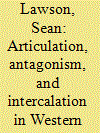|
|
|
Sort Order |
|
|
|
Items / Page
|
|
|
|
|
|
|
| Srl | Item |
| 1 |
ID:
104024


|
|
|
|
|
| Publication |
2011.
|
| Summary/Abstract |
This article provides a discursive grounding for understanding the construction of military imaginaries by adding the concepts of 'antagonism' and 'intercalation' to articulation theory. By examining the cases of industrial-mechanized warfare theory and network-centric warfare theory through the lens of this expanded articulation theory, it is argued that military imaginaries often serve to define and link conceptions of science, technology, society, economy, war, and military organization, thought, and practice into a unified image of the larger security environment - that is, the military imaginary. Military imaginaries often share a common narrative structure that privileges co-periodized change among the elements of the articulation, resulting in the phenomenon of 'antagonism' serving as a generic threat used to justify military modernization and even the use of force.
|
|
|
|
|
|
|
|
|
|
|
|
|
|
|
|
| 2 |
ID:
141462


|
|
|
|
|
| Summary/Abstract |
Despite a growing interest in the role of emotions in world politics, the relationship between emotion and securitization remains unclear. This article shows that persistent, if sporadic, references to fear and emotion in securitization studies remain largely untheorized and fall outside conventional linguistic and sociological ontologies. The tendency to discuss emotion but deny it ontological status has left securitization theory incoherent. This article offers a theoretical reconstruction of securitization where emotion, specifically collective fears, serve as the locus of an audience’s judgment for the practice of securitization. Yet rather than simply accepting that fear facilitates securitizing moves, the article draws on appraisal theory from psychology to argue that collective fear appraisals are often fragile cultural constructs. The generation of these emotional appraisals is often constrained by the limited symbolic resources of the local security imaginary and how agents contest and employ these resources. When the capacity to generate collective fears is constrained, so too is the practice of securitization. An empirical discussion of threat images in US foreign policy is used to explore these constraints. The tendency for securitizing moves to be interpreted as comic underscores the precariousness of social practices seeking to elicit particular collective emotions.
|
|
|
|
|
|
|
|
|
|
|
|
|
|
|
|
| 3 |
ID:
141781


|
|
|
|
|
| Summary/Abstract |
Despite a growing interest in the role of emotions in world politics, the relationship between emotion and securitization remains unclear. This article shows that persistent, if sporadic, references to fear and emotion in securitization studies remain largely untheorized and fall outside conventional linguistic and sociological ontologies. The tendency to discuss emotion but deny it ontological status has left securitization theory incoherent. This article offers a theoretical reconstruction of securitization where emotion, specifically collective fears, serve as the locus of an audience’s judgment for the practice of securitization. Yet rather than simply accepting that fear facilitates securitizing moves, the article draws on appraisal theory from psychology to argue that collective fear appraisals are often fragile cultural constructs. The generation of these emotional appraisals is often constrained by the limited symbolic resources of the local security imaginary and how agents contest and employ these resources. When the capacity to generate collective fears is constrained, so too is the practice of securitization. An empirical discussion of threat images in US foreign policy is used to explore these constraints. The tendency for securitizing moves to be interpreted as comic underscores the precariousness of social practices seeking to elicit particular collective emotions.
|
|
|
|
|
|
|
|
|
|
|
|
|
|
|
|
|
|
|
|
|